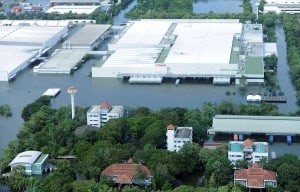 The recent flooding reported in Thailand is definitely going to impact the computer hard drive supply for at least the next six months, with Western Digital reporting that as much as a fifty percent reduction in production. Western Digital's main facility is mostly under water, and precision tools and clean rooms do not respond well to large quantities of muddy water. Since many of the component suppliers for hard drive manufactures are located in the same general area, the entire industry will be affected as companies clean up, purchase new equipment and retool. What does this mean for the consumer? Because computers are assembled largely in the Pacific Rim nations and work on a "just in time" supply basis, expect greater delays in receiving new machines and higher prices. In fact, be prepared to not be able to get certain size drives at any price. There have been reports that the supply chain is already starting to increase the price on existing stocks. The smart money would be to go ahead and purchase a new hard drive now, especially the higher capacity drives, even if you don't expect to use it for a few months. The other alternative would be to simply wait out the shortage, as often industries that suffer a supply chain problem over build and create excess product and prices drop accordingly.   The growing push toward cloud computing coupled with the price reductions in solid state drives (SSDs), at least in the 120 to 150 gigabyte range may push some PC laptop vendors to offer SSD drives while marketing cloud solutions to access user data. A lot will hinge on SSD suppliers willingness to cut prices further, possibly in exchange for significant order commitments from laptop OEMs to justify ramping up production. It is a big gap to consider. A 120 gigabyte SSD drives costs anywhere from $99 to $140 USD. $70 USD can buy one a top of the line two terabyte SATA drive. For most users, it is not even a question. Bear in mind while these are retail prices, the gulf between the respective cost per gigabyte is almost prohibitive. The growing push toward cloud computing coupled with the price reductions in solid state drives (SSDs), at least in the 120 to 150 gigabyte range may push some PC laptop vendors to offer SSD drives while marketing cloud solutions to access user data. A lot will hinge on SSD suppliers willingness to cut prices further, possibly in exchange for significant order commitments from laptop OEMs to justify ramping up production. It is a big gap to consider. A 120 gigabyte SSD drives costs anywhere from $99 to $140 USD. $70 USD can buy one a top of the line two terabyte SATA drive. For most users, it is not even a question. Bear in mind while these are retail prices, the gulf between the respective cost per gigabyte is almost prohibitive.Unless you don't have a choice, which is where the PC OEMs are or you see a chance to really gain a foothold in the market, which is the opportunity that the natural disaster in Thailand has created for the SSD makers. We shall see. Post from: Mighty Gadget - Gadget and Technology Blog |
Monday, October 24, 2011
Hard Drive Shortages Lead to Higher Prices-And SSDs in the Cloud?
Subscribe to:
Post Comments (Atom)





No comments:
Post a Comment